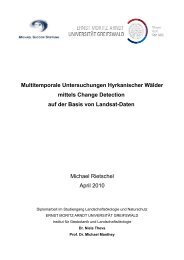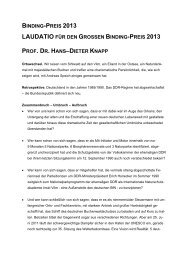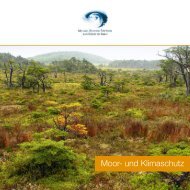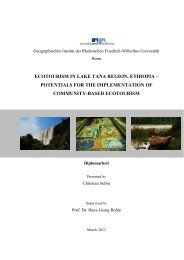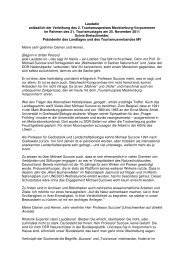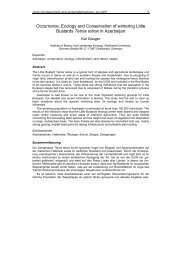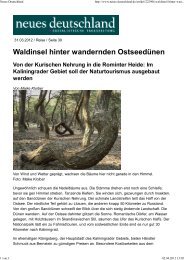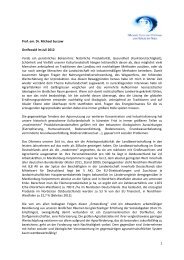Ecology and regeneration of forest communities on the alluvial fan ...
Ecology and regeneration of forest communities on the alluvial fan ...
Ecology and regeneration of forest communities on the alluvial fan ...
Create successful ePaper yourself
Turn your PDF publications into a flip-book with our unique Google optimized e-Paper software.
-Materials <str<strong>on</strong>g>and</str<strong>on</strong>g> Methodsagglomerative<br />
cluster analysis was applied to <strong>the</strong> transformed abundance data to<br />
classify <strong>the</strong> vegetati<strong>on</strong>. For distance measurement <strong>the</strong> square root <str<strong>on</strong>g>of</str<strong>on</strong>g> <strong>the</strong> Bray-Curtis<br />
coefficient, that has metric properties, was used.<br />
Table 3.1 Transformed abundance data <str<strong>on</strong>g>of</str<strong>on</strong>g> <strong>the</strong> North Carolina Index (NCI)<br />
NCI 0 1 2 3 4 5 6 7 8 9 10<br />
transformed values 0 0.1 0.5 1.5 3.5 7.5 17.5 37.5 62.5 85 97.5<br />
As linking procedure <strong>the</strong> ward’s minimum variance method (Ward 1963) was chosen to<br />
minimize <strong>the</strong> squared error for each clustering step. Species occurring in less than three<br />
plots were not included in this procedure. The socio-ecological species groups were<br />
arranged manually <str<strong>on</strong>g>and</str<strong>on</strong>g> <strong>the</strong> plant <str<strong>on</strong>g>communities</str<strong>on</strong>g> were arranged roughly al<strong>on</strong>g a moisture<br />
gradient. The vegetati<strong>on</strong> <str<strong>on</strong>g>communities</str<strong>on</strong>g> were named after two highly frequent species<br />
present within <strong>the</strong> community.<br />
To reveal <strong>the</strong> correlati<strong>on</strong>s with <strong>the</strong> site parameters, a Detrended Corresp<strong>on</strong>dence<br />
Analysis (DCA) was run with <strong>the</strong> program PCOrd (versi<strong>on</strong> 5.10.) without down<br />
weighting rare species <str<strong>on</strong>g>and</str<strong>on</strong>g> rescaling axes with 26 segments. All species, occurring less<br />
than three times in <strong>the</strong> whole dataset as well as species, that could <strong>on</strong>ly be determined to<br />
genus level were dropped. In order to test if <strong>the</strong> <str<strong>on</strong>g>forest</str<strong>on</strong>g> types could be distinguished <strong>on</strong>ly<br />
by means <str<strong>on</strong>g>of</str<strong>on</strong>g> <strong>the</strong>ir structure, this was repeatedly d<strong>on</strong>e using <strong>the</strong> importance values <str<strong>on</strong>g>of</str<strong>on</strong>g> <strong>the</strong><br />
tree species <str<strong>on</strong>g>and</str<strong>on</strong>g> <strong>the</strong> same site parameters.<br />
To reveal successi<strong>on</strong>al trends within <strong>the</strong> <str<strong>on</strong>g>communities</str<strong>on</strong>g> a n<strong>on</strong>-metric multidimensi<strong>on</strong>al<br />
scaling (NMDS) was made. For this purpose from each <str<strong>on</strong>g>of</str<strong>on</strong>g> <strong>the</strong> 59 sampling plots with<br />
complete informati<strong>on</strong> about canopy structure (PCQ) <str<strong>on</strong>g>and</str<strong>on</strong>g> rejuvenati<strong>on</strong> we created two<br />
corresp<strong>on</strong>ding “sub-plots”. To avoid distorti<strong>on</strong>s in <strong>the</strong> ordinati<strong>on</strong> scatter we restricted<br />
<strong>the</strong> analysis to 19 tree species that potentially can grow into <strong>the</strong> tree layers (Table 3.2).<br />
One sub-plot c<strong>on</strong>tained <strong>the</strong> importance values <str<strong>on</strong>g>of</str<strong>on</strong>g> <strong>the</strong> PCQ data <str<strong>on</strong>g>and</str<strong>on</strong>g> <strong>the</strong> sec<strong>on</strong>d sub-plot<br />
c<strong>on</strong>tained <strong>the</strong> importance values <str<strong>on</strong>g>of</str<strong>on</strong>g> <strong>the</strong> respective rejuvenati<strong>on</strong>. To generate importance<br />
values for <strong>the</strong> rejuvenati<strong>on</strong>, <strong>the</strong> numbers <str<strong>on</strong>g>of</str<strong>on</strong>g> individuals within each <str<strong>on</strong>g>of</str<strong>on</strong>g> <strong>the</strong> six different<br />
rejuvenati<strong>on</strong> classes were multiplied with a factor (seedling x 0.05 /



